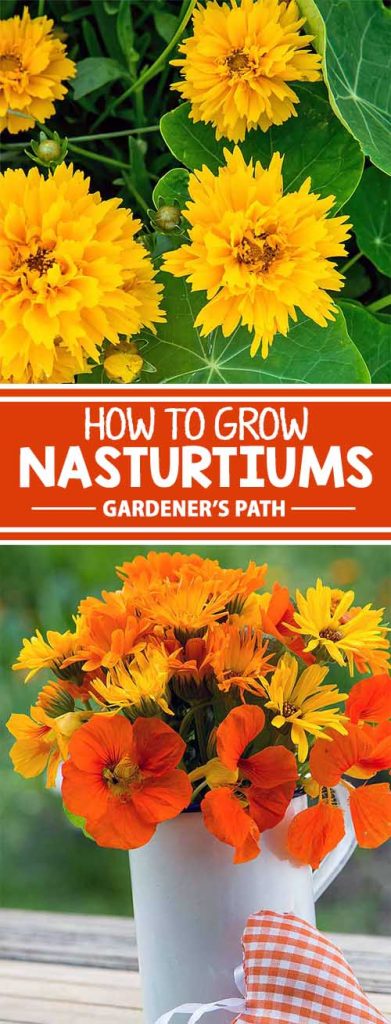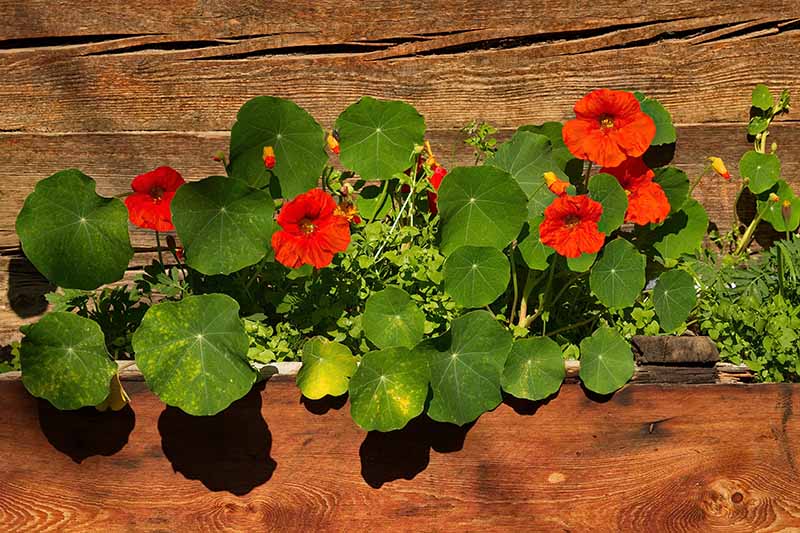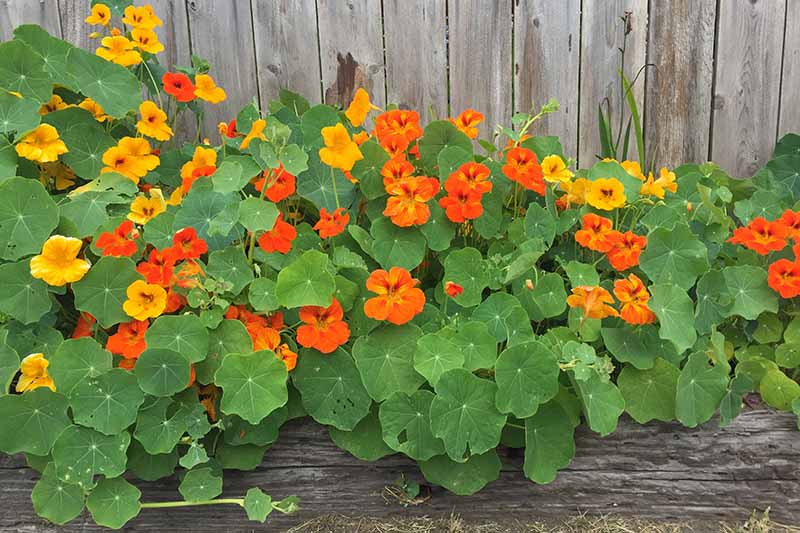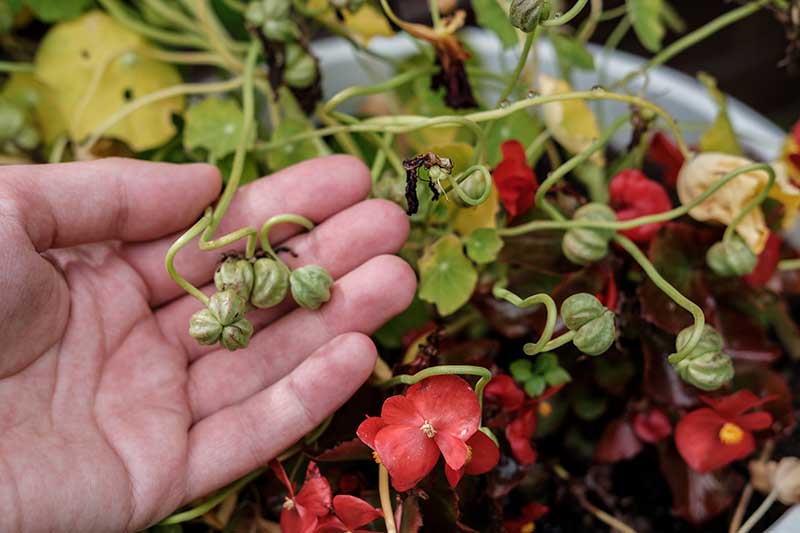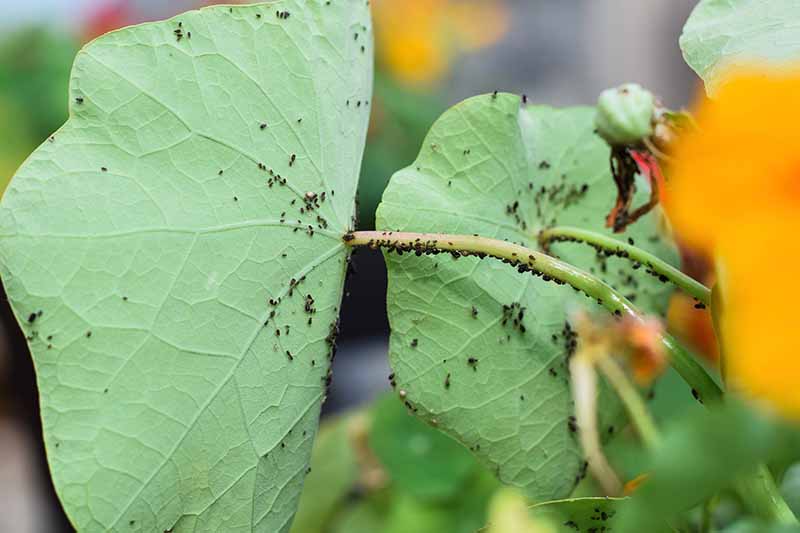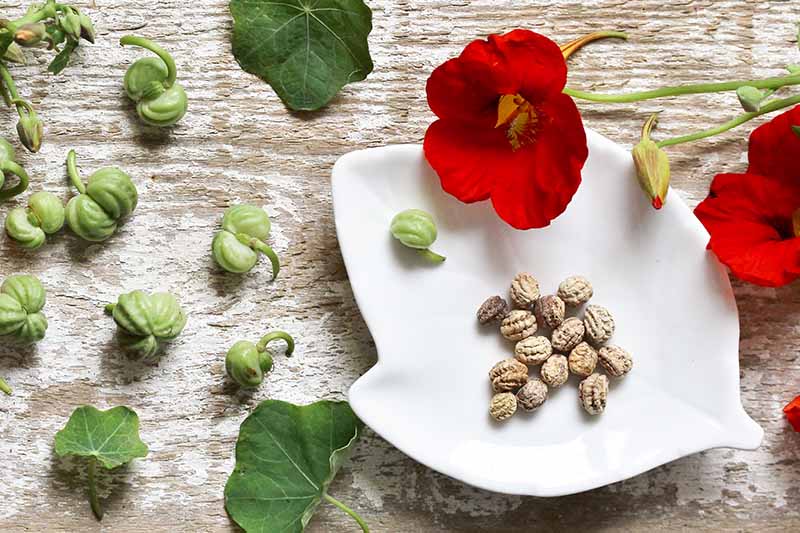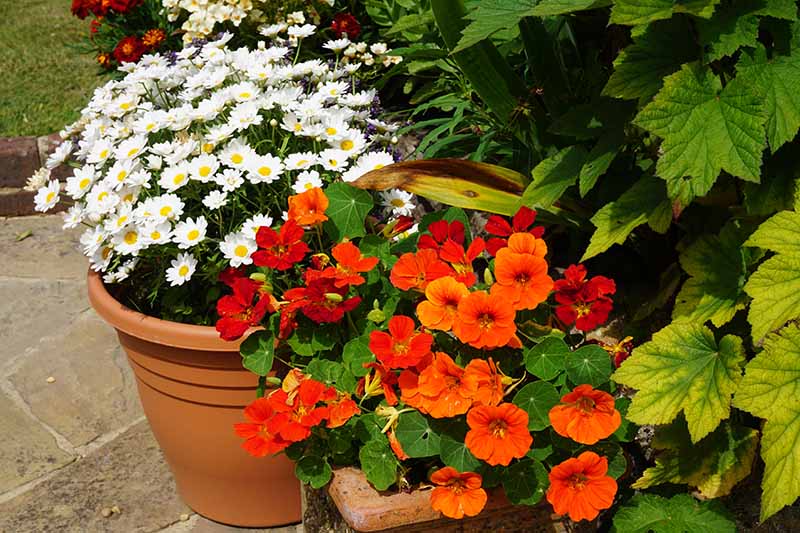With only a hint of care and attention, these fast-spreading plants put on a vibrant summer-long show. The intensely colored, trumpet-like flowers seem to float in a sea of green thanks to the ample supply of lush, rounded leaves. Wonderfully low maintenance, they thrive in poor soil, perform better when they’re not fertilized, and quickly fill in difficult spots where other plants dare not tread. They add sunny charm to beds, borders, hanging baskets, patio pots, and window boxes, and make a pretty weed break or an appealing, soft ground cover in areas with lean soil. We link to vendors to help you find relevant products. If you buy from one of our links, we may earn a commission. Pollinators love them too, with butterflies and hummingbirds drawn to the flowers’ rich nectar. And they’re entirely edible! Most of the plant parts, including seeds, leaves, and flowers, have a refreshing, peppery flavor. And both the flowers and leaves make a gorgeous garnish on any summer plate. Plus, they’re an attractive addition to floral arrangements, with long-lasting cut flowers and a light, spicy floral scent. Highly useful, you’ll love their easy-care versatility throughout the garden! Here’s all you need to know on how to plant nasturtiums.
What Are Nasturtiums?
Tropaeolum is the only genus in the Tropaeolaceae family and contains about 80 species of herbaceous plants, both annuals and perennials, native to the Andes Mountains of Bolivia, Columbia, and Peru. Those grown in home gardens are commonly called nasturtiums. Also known as Indian cress (from a time when the Americas were called the Indies), Mexican cress, or Peru cress, nasturtiums are fast growing, short-lived perennials in USDA Hardiness Zones 9-11, grown as annuals in other regions. They feature five-petaled, trumpet-shaped flowers with a distinctive back spur on long, slender stalks over a sea of round, jade green leaves. Flower colors are deep and intense in tropical shades of cream, fuchsia, mahogany, orange, pink, red, white, and yellow. Simple and easy to grow, plants reach a height of nine to 16 inches and can climb as much as 15 feet, depending on the species and their habit – which includes bush, cascading, and climbing forms. For cultivated ornamentals, among the most popular species are T. majus, T. minus, T. peregrinum, and T. speciosum. Named by Swedish botanist Carl Linnaeus, their shape reminded him of a Roman trophy pole (or tropaeum), with the round leaves being reminiscent of military shields, and the deep red flowers looking to him like blood-stained helmets. Tropaeolum should not be confused with the genus Nasturtium, which is best known for its flavorful cress plants such as N. microphyllum and N. officinale. The name nasturtium is from the Latin phrase “nasus tortus,” which means twisted or twitchy nose – at one time, the pungent plants were used for the relief of nasal and chest congestion. Both Tropaeolum and Nasturtium belong to the Brassicales order, but the only similarities they share are a light, spicy scent and bright, peppery taste common to mustard family members.
Cultivation and History
Seeds of T. minus were part of the conquistadors’ booty sent home to Spain in the 16th and 17th centuries. The pretty, fragrant, and fast-growing plants were used both for their culinary and their ornamental offerings. A Dutch monk, Pater Beverning, introduced the taller T. majus in the 1700s, which quickly prompted their use throughout Europe. Nasturtiums were introduced to North America in the early 1800s and, as in Europe, quickly grew in popularity thanks to their pretty flowers, fast growth, and climbing, camouflaging habit.
Propagation
Nasturtiums can be propagated from seed or via stem cuttings.
From Seed
Direct sowing seeds once the soil warms is the preferred propagation method, and it gives fast, reliable results. However, if you must start seeds indoors, use peat, paper, or other biodegradable pots to avoid root shock – nasturtiums don’t like to be transplanted. Here’s how to propagate from seed: Nasturtiums have a thick seed coat. To aid germination, this should be nicked with a file or soaked for up to 12 hours in lukewarm water. Plant seeds promptly after soaking. If you need to wait a few hours to plant, remove seeds from the water and lay between layers of moist paper towel. Direct sow beginning one week after the last frost, when soil temperatures reach 50°F, and repeat at two-week intervals until early summer. Plant seeds one-quarter to one-half inch deep and space six to 12 inches apart for small varieties, or up to 24 inches apart for the large ones. Water thoroughly with a gentle shower and keep soil moist until seeds sprout. The ideal soil temperature for germination is 55 to 65°F, and seeds sprout in seven to 14 days.
From Stem Cuttings
Stem cuttings for propagation are best taken in spring, when temperatures are mild. Here’s how:
Snip a piece of stem four to six inches in length, cutting one to two inches below a leaf node (where the leaf joins the stem).Remove leaves from the lower two-thirds of the stem.Dip the stem in rooting compound up to the leaf node, if desired.Fill small, two- to four-inch biodegradable pots with a light potting soil mix.Insert cuttings, one or two per pot, and firm soil gently around the stems.Place pots in a protected location with morning sun and afternoon shade.Roots have formed when new leaves begin to emerge, in two to three weeks.
Transplant out to the garden in their biodegradable pots to avoid root disturbance.
How to Grow
Tropaeolum plants require a full sun location and well-draining soil of a poor, lean quality, with a light or sandy texture. They do best in a neutral soil with a pH of 6.1 to 7.8. Plants can tolerate partial shade but will produce more abundant foliage than flowers. Soil that’s too rich also produces fast-growing greenery but few flowers. And Tropaeolum doesn’t require fertilizer. Even when grown in containers, these plants don’t require the same amount of feeding, if any, as some other annuals. Keep weeds under control with a two-inch mulch of leaf mold or straw, and water plants regularly. Tougher than they look, established plants can handle periods of drought and high temperatures – although they can suffer leaf scorching in excessively hot afternoon sunshine. If desired, feed container plants once in late spring with a balanced or low nitrogen fertilizer. At the same time, trim lightly to encourage new growth.
Growing Tips
The following tips will help you get the most from your nasturtium plants:
If starting indoors, use biodegradable pots to prevent root shock.Nasturtiums prefer poor soil and require no fertilizing.Provide a trellis or netting for vertical support.For abundant foliage, plant in partial shade.
Pruning and Maintenance
The occasional grooming or deadheading of flowers helps to encourage new flowers to form. If plants get a bit strung out or lanky, prune back by up to one half of their volume and they’ll quickly produce new growth. In late spring or early summer, give plants a light trim to restore shape and encourage new flower production. For climbing varieties, provide support like a trellis or pea netting. You may have to point the climbers in the right direction to get them started. Grown in containers, they benefit from the occasional trim to maintain a tidy shape and to keep flower production high. Should vigor start to decline in summer’s heat, cut plants back by as much as half. They’ll regrow with renewed vitality as soon as cooler evening temperatures return. To collect seed for stock, allow seed pods to fully ripen on the vine. They will change in color from green to a light tan. Allow seeds to release on their own, collecting them after they fall to the ground. Brush gently to remove any dirt. Spread out on a plate or tray and allow to dry for another two to four weeks in a warm, dry environment. Seeds need to be completely dry before storing. When seeds are dry and have darkened to brown, package them in glass jars or paper envelopes and store in a cool, dark cupboard. After plants are felled by frost in cooler zones, remove the remaining debris to prevent overwintering of unfriendly pests. Have a look at our guide to learn more about how to care for nasturtiums in winter.
Managing Pests and Disease
Largely disease free, there are a few pests and problems to watch out for.
Alaska
The ‘Alaska’ mix of T. nanum is a dwarf variety with edible flowers in shades of cherry, cream, crimson, gold, and orange with pretty variegated foliage. ‘Alaska’ Plants reach a height of eight to 14 inches and add charm to beds, borders, containers, and window boxes. Seed packets of varying sizes are available at True Leaf Market.
Empress of India
With a bewitching color combination of bright scarlet flowers amid deep blue-green leaves, T. minus ‘Empress of India’ is a handsome dwarf cultivar. ‘Empress of India’ A mesmerizing beauty for beds, borders, patio pots, and window boxes, plants grow six to 12 inches tall and have a similar spread. Seed packets are available at Eden Brothers.
Jewel
The T. majus ‘Jewel’ mix is a fast growing variety with flower colors of canary, carmine, peach, and salmon on plants with a dwarfed habit. ‘Jewel’ The sparkling plants add color to beds, containers, or climbing short trellises. Growth is 12 to 18 inches tall with an 18- to 24-inch spread. Seed packets are available at True Leaf Market.
Moonlight
T. lobbianum ‘Moonlight’ features long, trailing vines heavily adorned in creamy white flowers with chartreuse throats. ‘Moonlight’ A beautiful choice on fences or trellises, as a groundcover, and simply gorgeous when dripping heavily from hanging baskets, plants grow 10 to 12 inches tall with a spread of up to 78 inches. Seed packets and sacks are available at Eden Brothers.
Spitfire
T. lobbianum ‘Spitfire’ has fiery orange-red flowers and soft, glaucous green leaves on long, sprawling stems. An eye-popper when trained along foundation walls, up fences and trellises, or cascading from hanging baskets, plants grow 10 to 14 inches tall and reach up to 78 inches. ‘Spitfire’ You can find seeds in a variety of packet sizes available at Eden Brothers.
Pests
Aphids are small black, green, or reddish sapsuckers that spread disease as they feed on flowers, leaves, and stems. Control aphids with a strong stream of water from a garden hose, targeting stems and the underside of flowers and leaves. Cabbage loopers are green worms that eat the foliage and lay eggs on the plants. Hand pick and remove them. Leafhoppers are another small, sapsucking, and disease-spreading insect with strong rear legs used for jumping from leaf to leaf. Control infestations of leafhoppers with an insecticidal soap. Leafminers are small black or gray flies that bore into leaves to lay their eggs, causing bleached, serpentine tracks on leaves as they grow. Remove and destroy infected leaves and spray with neem oil to control adults. Keep beds clean of debris and use fresh dirt next spring as flies can overwinter in the soil. Slugs and snails dine on foliage, leaving irregular notches or eating entire leaves. Handpick slugs and snails and dispose of them. Learn more about identifying and controlling nasturtium pests here.
Disease
Aster yellows is caused by a minute organism known as a phytoplasma and causes stunting or witches’ brooms – excessive leafy growth on green, deformed flower petals. Leafhoppers spread this bacteria-like pathogen. Remove and destroy infected plants immediately. Control leafhopper populations and keep the weeds down, which may also host the disease. Caused by Plasmodiophora brassicae, clubroot is a fungal disease that occurs most frequently in acidic soil or locations where Brassica species have previously grown. Leaves can be stunted or wilt, and affected roots are heavily clubbed or distorted. Remove and destroy plants if you see signs of this disease. Add lime to acidic soils and avoid replanting in the same location. A variety of bacterial pathogens may infect plants with mosaic virus. It causes light to dark green spotting or mottling on the leaves, and malformed or splotchy flowers. Mosaic viruses are transmitted by aphids and leafhoppers. Remove and destroy infected plants and treat for pest infestations as needed. Wilt, caused by Pseudomonas solanacearum, is a bacterial infection that lives in plant debris and invades roots from the soil. Plants yellow and wilt before dying, and can develop black streaks or an oozing slime at cut sites. Remove and destroy infected plants, and disinfect any tools that have come in contact with plants in a 10 percent bleach to water solution. Also, avoid overhead watering – this bacteria is easily spread by splashing water. Ensure plant beds are cleaned of debris before winter. Find tips on identifying and treating nasturtium plant diseases here.
Harvesting
To harvest for kitchen use, clip leaves and flowers with a clean knife or scissors at any time throughout the growing season. Rinse gently under cool running water and spin dry in a salad spinner, or pat dry with a clean dish towel. For pickled seed pods, harvest seeds while they are still green and tender.
Preserving
The immature green pods are delicious when pickled. Known as “poor man’s capers,” they make an excellent substitute for the real thing. A simple way to do this is to collect the pods, wash them gently to remove any dirt, and place them in a jar. Measure out enough white vinegar to cover the pods, and place it in a saucepan with a teaspoon of salt for every cup of vinegar used, and a bay leaf. Bring to the boil, then remove from heat and pour over the pods, ensuring that the vinegar and salt solution covers them completely. Seal the jar, allow it to cool, and refrigerate. After two to three months they will be ready to use.
Recipes and Cooking Ideas
For an appetizer, stuff flowers with softened cream cheese or goat cheese mixed with fresh herbs. Use whole or shredded leaves and flowers to add piquant flavor to salads and pasta. Flower buds make a bright and tasty addition to stir fries. Minced leaves and flowers make a delicious, tangy compound butter for fresh bread, seafood, steak, and vegetables. And as a plate garnish, the bold beauty of the flowers is unsurpassed! Here’s a friendly reminder: when selecting edible flowers, the use of clean, organic gardening practices delivers the healthiest results. We have more tips on harvesting and using nasturtium flowers and plants here.
Best Ornamental Uses
The climbing or trailing varieties of Tropaeolum give outstanding vertical growth and terrific color when scaling up arbors, fences, and trellises, or pouring down from hanging baskets and window boxes. Compact varieties add flair to raised beds and borders, and make spectacular spillers in containers, or tumbling over the edges of low foundation walls and rock garden pockets. With fast-growing, ample foliage, nasturtiums make a decorative and effective scrambling ground cover for concealing stumps or ugly spots, and serve as a weed barrier to protect against encroachment of the garden or lawn. And the generous foliage works well as a filler or seasonal screen in difficult areas, such as under decks or stairs, poor soil locations, and shady spots. As companion plants, nasturtiums make a good trap crop for aphids. When used as a trap, plant near the crops you want to protect, then hose off aphids as needed. They also deter many caterpillars, cucumber beetles, squash bugs, and whiteflies, and attract predatory insects such as ladybugs, lacewings, and parasitic wasps. Tropaeolum plants may be used as a companion for Brassicas, cucumbers, melons, radishes, and tomatoes. And because of their many outstanding characteristics and quick growth, nasturtiums are always a good choice for children’s gardens. Simple to grow from seed, these no-fuss annuals provide dazzling color from spring until frost in a variety of settings. In addition to readily self-seeding, they may be grown as perennials in warmer zones as well. Provide them with a sunny location for the best flower production, give them excellent drainage, and water when dry. But ease up on the fertilizer! Unless you want to use the foliage as a fill-in plant for tricky spots, no feeding is required. How do you folks like to use nasturtiums? Shoot us a line in the comments below! And for more information on growing edible flowers, check out these guides next:
How to Grow Pot Marigold (Calendula) FlowersHow to Grow and Care for Dame’s RocketSplash Your Garden in Blue with Bachelor’s Button (Cornflower)
